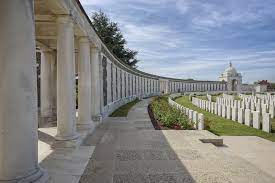William Ingle
Date of birth: 1896
Date of death: 16.08.1917
Area: Outwood, Wakefield
Regiment: 7th Battalion, King’s own Yorkshire Light Infantry
Family information: Youngest son of George and Selina Ingle
Rank: Private
Service number: 20034
War Service
When war was declared on 4th August 1914, William was living with his father at Rydal Mount, Silver Street, Outwood. In the following November, William Ingle enlisted in the Kings Own Yorkshire Light Infantry. Private William Ingle arrived in France on 7th August 1915, and later joined the 7th KOYLI
The 7th (Service) Battalion, attached to the 61st Brigade, 20th (Light) Division, moved to France on 22nd July 1915. Towards the end of September 1915, the 7th KOYLI went into the line in the Laventie sector, three miles north of Neuve Chapelle. The 7th KOYLI remained in Flanders for some time and in February 1916 they were deployed in the northern part of the Ypres Salient. This was a particularly active area and the battalion sustained a number of casualties.
The Battle of the Somme began on 1st July 1916, but the 20th Division was not involved until late August. On 22nd August the 7th KOYLI went into the trenches opposite Ginchy, during the Guillemont operations. At noon on 3rd September, the 7th KOYLI was in support during the 20th Division attack on Guillemont. On the 16th September, during the third phase of the Battle of the Somme, 61st Brigade was involved in an attack towards Les Boeufs and gained some ground. However, due to lack of support on the left flank, they had to consolidate the line gained, which was about 400 yards from their objective. The 7th KOYLI returned to the action on the 18th September and again on the 7th October, when the final thrust was delivered. The 7th KOYLI, in Division, was to remain on the Somme throughout the winter months.
On the 21st July 1917, the 7th KOYLI moved north to Proven, to prepare for the third Battle of Ypres, which was to begin on the 31st July. A short tour in the line followed, when the battalion experienced mustard gas for the first time.
On 15th August, the 7th KOYLI, in Brigade, was in assembly positions on the forward slopes of Pilkem Ridge. At 03.30 hrs. on 16th August, under an intense barrage, 7th KOYLI advanced towards the village of Langemarck. The ground in front was covered in water-filled shell holes and it was difficult to keep pace with the creeping barrage, as men became stuck in the mud. By the time they were 100 yards from their first objective, almost half the battalion were casualties from machine-gun fire. With the first objective taken, the battalion found the ground to the second objective was a sea of mud. With the direct line impassable, the battalion progressed around the swamp and reached their second objective and dug in. There was enemy shelling for the rest of the day, but the battalion remained in these positions, until relieved during the night of 17th August. The 7th KOYLI sustained over 200 casualties during the attack.
Initially reported wounded and missing, Private William Ingle was in fact killed in action on the 16th August 1917. His body was not identified and his name is included on the Tyne Cot Memorial. Some 9 km. east of Ypres, the Memorial forms the north-east boundary of the Tyne Cot Cemetery. The Memorial also marks the furthest point reached by Commonwealth forces in Belgium, until nearly the end of the war. There are almost 35000 names, of officers and men from the United Kingdom and New Zealand, inscribed on the walls. All of whom died on the Ypres Salient after 16th August 1917 and have no known grave.
Family Life
William Ingle was born on 5th February 1896, the youngest son of George and Selina Ingle, of Coach Road, Outwood. He was baptised two months later, on 5th April, at St Mary Magdalene Church, Outwood. At this time, George Ingle, his father, was employed as a foreman road maker, however he soon progressed to become Highway Surveyor, for Stanley Urban Council. In February 1902, with William just six years old, his mother, Selina Ingle, died, aged 40 years. Later the family moved to May Villas, in Ledger Lane and William attended the nearby Council School. Whilst at Ledger Lane Council School he won a scholarship which entitled him to attend the Wakefield Grammar School. On leaving school, William Ingle was employed in the Engineering Department, at Lofthouse Colliery.
 Tyne Cot Memorial
Tyne Cot Memorial

